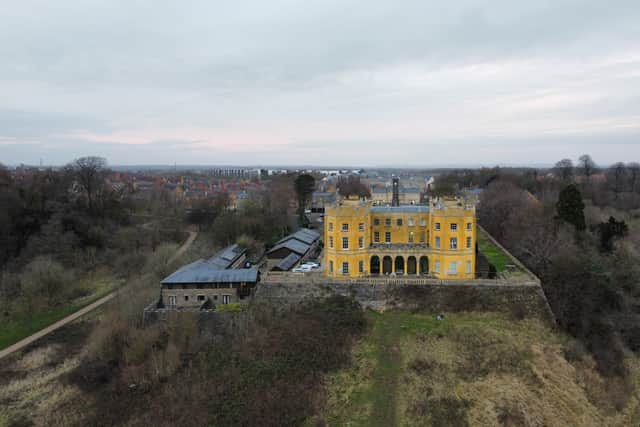Stoke Park Dower House: The fascinating backstory of the mysterious yellow M32 manor
and live on Freeview channel 276
Many motorists who have had the luxury of driving into Bristol on the M32 will have probably noticed a particularly colourful sight along the way. A ray of yellow against the screen of green - a 16th century manor stands on a tall grassy bank.
The home is Stoke Park’s Dower House - built in 1556 for Sir Richard Berkeley MP. The stately home is shrouded in mystery to the many who notice it every day but when you understand its history you may be left with more questions than answers.
Advertisement
Hide AdAdvertisement
Hide AdFrom comparisons to Windsor and its royal tenants to its use as a children’s hospital and countless tales of ghosts roaming its long corridors, here is an overview of its past.
Early days
As previously mentioned, the home was completed in 1556 by Sir Richard Berkeley who would later go on to become the sheriff of Gloucestershire in 1564 and be elected as the member of parliament for the area in 1604 - the same year he would die.
Originally called Stoke Lodge, it did not serve as Sir Berkeley’s main residence and its grounds appear to have been selected for their defensible position with its sizeable revetment, which raised it high above the surrounding land. Another theory is that the site was chosen to be a grand hunting lodge giving his guests a panoramic view of the chase.
18th Century rebuild
By the mid-18th century, the estate had passed through the generations of the Berkeley family. In 1736, it was inherited by Norborne Berkeley, who rebuilt it around 1760 in Strawberry Hill Gothic style. He would also rename it Stoke Park. This period is considered to be the grounds’ heydey as it drew comparisons with Windsor.


Advertisement
Hide AdAdvertisement
Hide AdThe grounds were transformed to allow for carriage drives and woodland walks for visitors to enjoy the viewpoints afforded by the elevated platforms. A large pond and obelisk in memory of Berkely’s niece, Elizabeth Somerset who was killed in a riding accident after breaking her neck during a fall, was also added to the plot. Elizabeth is rumoured to haunt the grounds with tenants and visitors in more recent years reporting that they could hear hooves galloping through the corridors and that they have seen the girl.
Norborne Berkeley would eventually flee the country in 1768 after becoming bankrupt, leaving Stoke Park to his sister, the Dowager Duchess of Beaufort – hence its change of name to Dower House. She would die in 1799 leaving Dower House in limbo for several years as tenants came and went.
Conversion into a children’s hospital
In the late 19th century, it was briefly the home of the Duke and Duchess of Beaufort before being sold in 1909 to the Rev Harold Burden.
Rev Burden and his wife Katherine would convert the estate into a hospital for children with mental health issues and learning difficulties, Stoke Park Colony. Most patients were long-term residents at the hospital which tended to both adults and children of all ages and a school was based on-site.
Advertisement
Hide AdAdvertisement
Hide AdThe Colony expanded by buying surrounding land and building accommodation blocks. In 1917, it was granted an expanded licence for 1,528 “inmates” - this made it Britain’s largest licensed institution at the time. In 1950, it would be known as Stoke Park Hospital. The house closed as hospital wards in late 1986 when the final remaining patients were moved elsewhere.
The 90s to modern day
The Sennitt and Neate families purchased Dower House in 1991 with plans to redevelop the house into a nursing home. Initially, it was rented to the nearby University of the West of England (UWE) for lectures and seminars in the meantime, while the facilities at UWE’s Frenchay campus were redeveloped.
Residential planning permission was sought, but in 1998, before any planning permission was granted, the house was once again sold on to a consortium of housing developers. The last UWE lecture was in the spring of 2003. The main house was converted into 13 apartments in 2004.
The estate is now maintained as an open space by Bristol City Council, known as Stoke Park Estate. The building is Grade II listed but is not open to the public.
Comment Guidelines
National World encourages reader discussion on our stories. User feedback, insights and back-and-forth exchanges add a rich layer of context to reporting. Please review our Community Guidelines before commenting.
